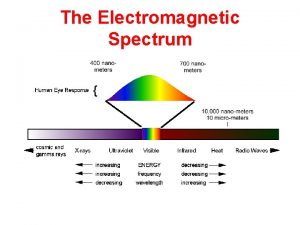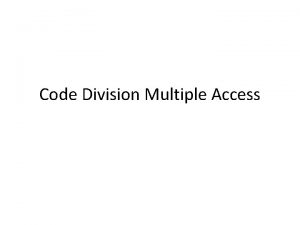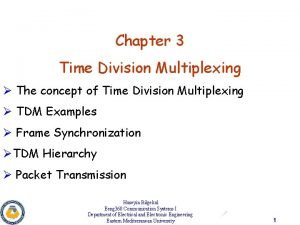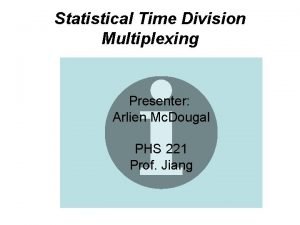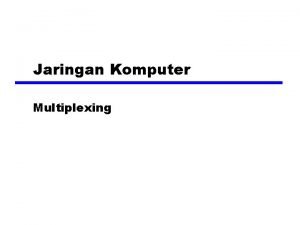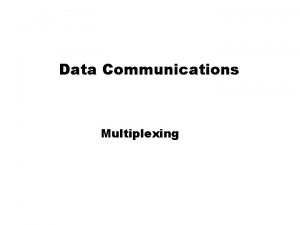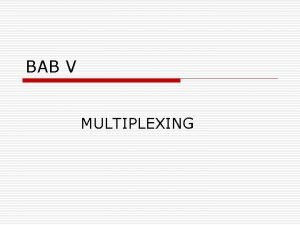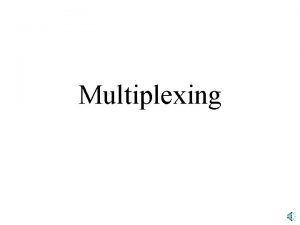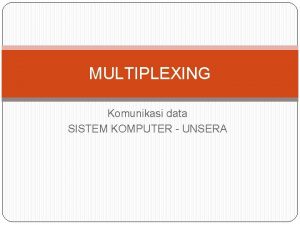Dense Wavelength Division Multiplexing Food For The Internet
















- Slides: 16

Dense Wavelength Division Multiplexing Food For The Internet

Definition Dense wavelength division multiplexing (DWDM) is a fiberoptic transmission technique that employs light wavelengths to transmit data parallel-by-bit or serial-by-character.

The Challenges of Today's Telecommunications Network • Traffic generated by Internet access (300 percent growth per year). • Fiber exhaust in their networks. An industry survey indicated that in 1995, the amount of embedded fiber already in use in the average network was between 70 percent and 80 percent. Today, many carriers are nearing one hundred–percent capacity utilization across significant portions of their networks. • Use of DWDM allows providers to offer services such as email, video, and multimedia carried as Internet protocol (IP) data over asynchronous transfer mode (ATM) and voice carried over SONET/SDH.


Resolving the Capacity Crisis • Lay More Fiber • TDM • WDM • DWDM

Capacity Expansion and Flexibility: DWDM • Dense wavelength division multiplexing (DWDM), which increases the capacity of embedded fiber by first assigning incoming optical signals to specific frequencies (wavelength, lambda) within a designated frequency band then multiplexing the resulting signals out onto one fiber. • DWDM combines multiple optical signals so that they can be amplified as a group and transported over a single fiber to increase capacity A system with DWDM can achieve all this gracefully while maintaining the same degree of system performance, reliability, and robustness as current transport systems—or even surpassing it. Future DWDM terminals will carry up to 80 wavelengths of OC– 48, a total of 200 Gbps, or up to 40 wavelengths of OC– 192, a total of 400 Gbps—which is enough capacity to transmit 90, 000 volumes of an encyclopedia in one second.






Capacity Expansion Potential By beginning with DWDM, service providers can establish a grow-as-you-go infrastructure, which allows them to add current and next-generation TDM systems for virtually endless capacity expansion (see Figure 4). DWDM also gives service providers the flexibility to expand capacity in any portion of their networks—an advantage no other technology can offer.


International Perspectives • In 1996, about 76 million km of fiber had been installed worldwide with that number increasing to over 150 million by 2000—a growth rate of 26 percent • The DWDM market will grow from $980 million in 1998 to $5. 2 billion in 2003. The first deployments of WDM systems were in the US, but this has now expanded to the UK, Italy, France, Norway, Finland, Japan, China and Korea. • European sales grew 25% last year to $5 billion. As with WDM, the principal drivers were the Internet, transcontinental deployment, an increase in global connectivity through transoceanic links, and network expansion by all types of carrier including the city carriers.

Considerations At any instant in time, the service providers and carriers will have excess idle bandwidth and processing capacity. The sheer magnitude of this capacity will make it a commodity. Much like other commodities, a virtual real-time trading floor will develop for buying and selling transmission capacity (in the form of Mbps) and processing power (in the form of giga instructions/sec). In 20 years, developing countries will provide the almost universal access currently enjoyed by developed countries. Universal device mobility will be the norm. Universal access to people and information will have significant social and political consequences, generating privacy, security, economic, and national sovereignty policy issues, which individuals and governments will struggle to address

Conclusion Optical networking provides the backbone to support existing and emerging technologies with almost limitless amounts of bandwidth capacity. All-optical networking (not just point-to-point transport) enabled by optical cross-connects, optical programmable add/drop multiplexers, and optical switches provides a unified infrastructure capable of meeting the telecommunications demands of today and tomorrow. Transparently moving trillions of bits of information efficiently and cost-effectively will enable service providers to maximize their embedded infrastructure and position themselves for the capacity demand of the next millennium. http: //webevents. broadcast. com/ciena/optics 0101/home. asp
 Dwdm presentation
Dwdm presentation Upward multiplexing and downward multiplexing
Upward multiplexing and downward multiplexing Upward and downward multiplexing
Upward and downward multiplexing Which layer is the least dense
Which layer is the least dense The layers of earth from most dense to least dense
The layers of earth from most dense to least dense The earth's layers foldable
The earth's layers foldable Longest wavelength in electromagnetic spectrum
Longest wavelength in electromagnetic spectrum Code division multiplexing
Code division multiplexing Time division multiplexing tdm block diagram
Time division multiplexing tdm block diagram Statistical tdm
Statistical tdm Long term evolution - advanced
Long term evolution - advanced Unit 2 food food food
Unit 2 food food food Grazing food chain diagram
Grazing food chain diagram Short division vs long division
Short division vs long division Syntehtic division
Syntehtic division Whats a dividend in math
Whats a dividend in math It is the shorthand method of polynomial division
It is the shorthand method of polynomial division






